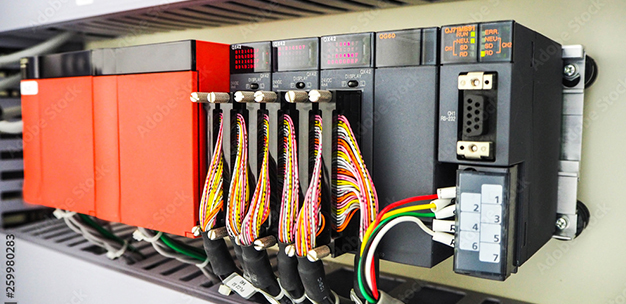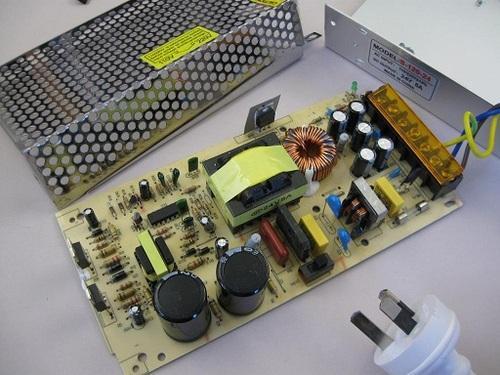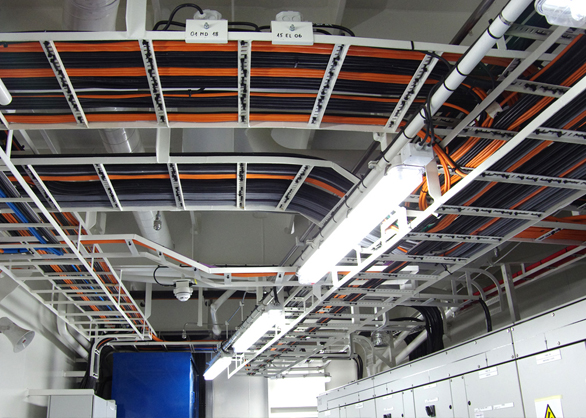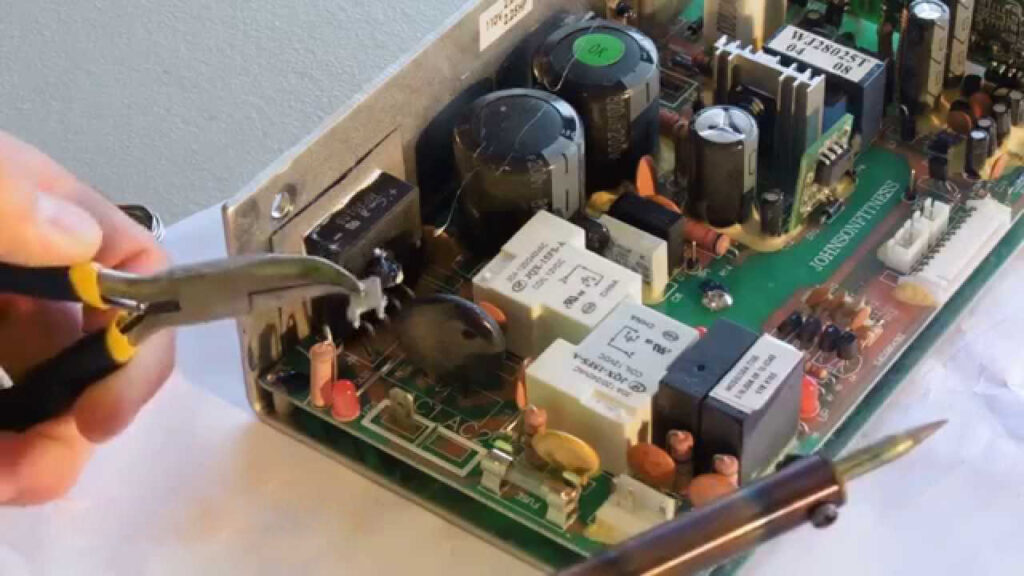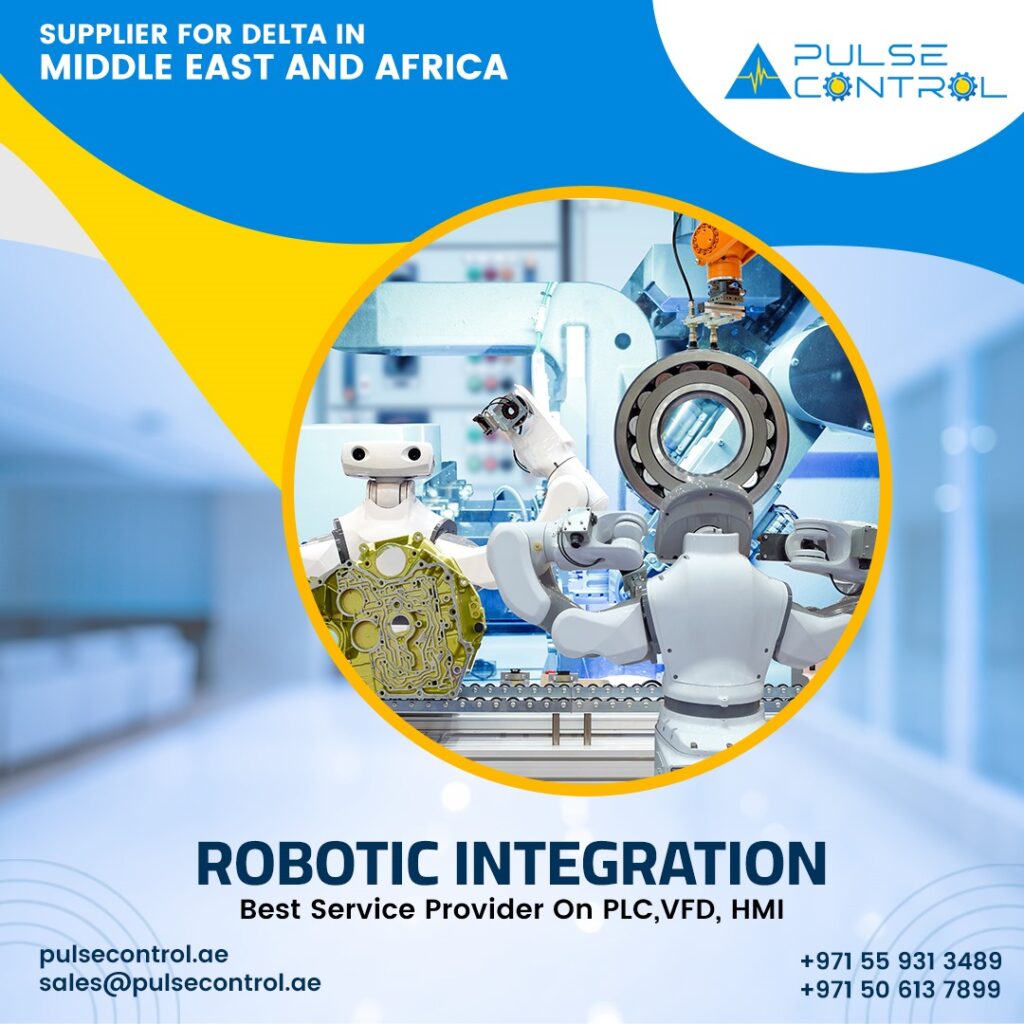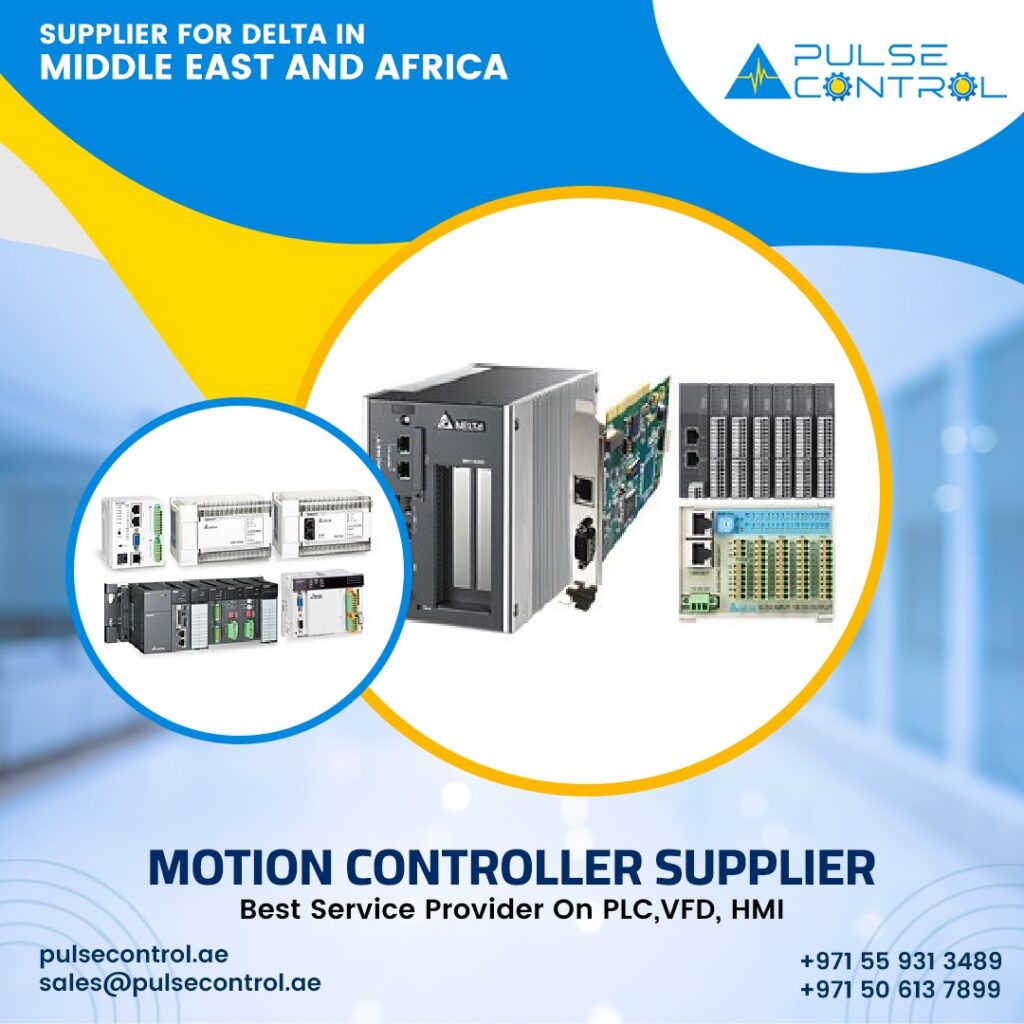Motion Controller
is an essential component in automated systems that manage the movement of machinery, robots, and other equipment with high precision. By interpreting commands from a host computer or control system, motion controllers direct actuators and motors to achieve desired positions, velocities, and accelerations. Here’s a detailed explanation of motion controllers, their functions, types, and applications:
1. Overview and Functionality
Definition: A is an electronic device that coordinates the movement of one or more axes in a system. It takes input signals (such as position commands) and translates them into control signals for motors or actuators.
Key Functions:
Control Algorithms: Motion controllers use various algorithms (like PID control) to maintain precise control over the position, velocity, and acceleration of motors.
Feedback Systems: Many motion controllers incorporate feedback loops to monitor the actual position and speed of the moving parts, allowing for real-time adjustments.
Path Planning: Some advanced controllers can calculate optimal paths for movement, reducing cycle time and improving efficiency.
Open-Loop Controllers: These controllers send commands to the motor without feedback. They are simpler and less expensive but may lack precision since they cannot correct errors in real time.
Closed-Loop Controllers: These use feedback from sensors (like encoders) to continually adjust the motor’s operation. They provide higher accuracy and reliability, making them suitable for applications requiring precision.
Multi-Axis Controllers: These can control multiple motors simultaneously, coordinating complex movements across several axes. They are commonly used in robotic arms and CNC machines.
Ethernet-Based Controllers: With the rise of Industry 4.0, many motion controllers now support Ethernet communication protocols, enabling easier integration with networked systems and IoT applications.
3. Applications
Robotics: are crucial in robotic applications, enabling precise movement for tasks such as assembly, welding, and painting. They help ensure that robotic arms move smoothly and accurately.
CNC Machines: In computer numerical control (CNC) machinery, guide the cutting tools along predetermined paths, enhancing the accuracy and repeatability of machining processes.
Conveyors and Material Hand manage the movement of conveyor belts and material handling equipment, ensuring products are transported efficiently and safely.
Aerospace and Defense:s are used in flight simulators and defense applications where precise movement is critical for training and operational success.
4. Benefits
Precision and Accuracy: enhance the accuracy of movement, reducing errors and improving product quality.
Speed and Efficiency: By optimizing movement paths and controlling speeds, motion controllers can significantly increase the efficiency of manufacturing processes.
Flexibility: Many can be programmed for different tasks, making them versatile tools in automated systems.
Integration with Other Systems: can often be integrated with other control systems, allowing for coordinated control of multiple functions within an automated process.
5. Challenges
Complexity of Implementation: Setting up systems can be complex, requiring careful calibration and programming to achieve desired performance.
Cost Considerations: Advanced motion controllers can be expensive, particularly those with multi-axis capabilities and feedback systems.
Maintenance and Troubleshooting: As with any electronic device, motion controllers can require maintenance, and troubleshooting issues may necessitate specialized knowledge.
Conclusion
In summary, motion controllers are pivotal in modern automation and robotics, providing the necessary precision and control for various applications. Their ability to interpret commands and adjust motor movements in real-time allows for enhanced efficiency, flexibility, and accuracy in production processes. As technology continues to advance, motion controllers are likely to become even more sophisticated, further integrating into smart manufacturing and Industry 4.0 initiatives.come in various types, each designed to meet specific application requirements and operational complexities. Here are the main types of motion controllers:
1. Open-Loop Controllers
Description: These controllers operate without feedback mechanisms. They send commands to the motors or actuators based solely on predefined inputs.
Applications: Often used in simple systems where precise positioning isn't critical, such as basic conveyor belts or simple robotic systems.
Advantages: Simplicity and lower cost; easier to implement.
Disadvantages: Lack of accuracy; cannot correct errors or compensate for external disturbances.
2. Closed-Loop Controllers
Description: These controllers utilize feedback from sensors (such as encoders or resolvers) to monitor the actual position and speed of the motors. They continually adjust the control signals based on this feedback.
Applications: Commonly used in applications requiring high precision, such as CNC machines, robotics, and servo systems.
Advantages: Higher accuracy, reliability, and responsiveness; can correct errors in real time.
Disadvantages: More complex and potentially more expensive due to the need for additional components like sensors.
3. Single-Axis Controllers
Description: These controllers are designed to control the motion of a single axis. They can be either open-loop or closed-loop systems.
Applications: Typically found in simple applications such as linear actuators or single motor drives.
Advantages: Simplified control and programming; ideal for straightforward tasks.
Disadvantages: Limited to applications that require control of only one axis.
4. Multi-Axis Controllers
Description: Capable of controlling multiple axes simultaneously, these controllers coordinate the movements of several motors to achieve complex tasks.
Applications: Used in robotic arms, CNC machines, and automated production lines where synchronized movement is essential.
Advantages: Enables complex motion sequences; improves efficiency and productivity.
Disadvantages: Increased complexity in setup and programming; may require advanced knowledge of motion control.
5. Servo Controllers
Description: These are specialized closed-loop controllers designed specifically for servo motors. They provide precise control over position, speed, and torque.
Applications: Common in robotics, CNC machines, and automation systems where accurate motion control is required.
Advantages: High precision and responsiveness; ideal for dynamic applications.
Disadvantages: Can be more expensive than other types of controllers; requires careful tuning for optimal performance.
6. Stepper Motor Controllers
Description: Designed to control stepper motors, these controllers send pulse signals to control the motor's position and speed. They can be either open-loop or closed-loop, but many applications utilize closed-loop systems for better performance.
Applications: Often used in 3D printers, CNC routers, and other applications requiring precise positioning.
Advantages: Simplicity of control; relatively low cost; good for applications with moderate speed and torque requirements.
Disadvantages: Can lose steps if overloaded, resulting in loss of position accuracy.
7. Ethernet-Based Controllers
Description: These controllers utilize Ethernet communication protocols to connect to other devices, enabling integration with networked systems.
Applications: Common in modern industrial automation, allowing for real-time data exchange and remote control.
Advantages: Easy integration into Industry 4.0 systems; facilitates remote monitoring and control.
Disadvantages: Requires network infrastructure; potential security concerns.
8.
Description: These controllers allow users to program motion sequences and parameters using specialized software. They may control multiple axes and integrate with various sensors and inputs.
Applications: Used in complex automation systems, such as robotic systems, conveyor systems, and assembly lines.
Advantages: High flexibility and adaptability; can be tailored to specific applications.
Disadvantages: Requires expertise in programming; initial setup can be time-consuming.
Conclusion
The choice of motion controller depends on the specific requirements of the application, including factors like precision, complexity, and cost. By understanding the different types of motion controllers available, manufacturers and engineers can select the most suitable option to achieve optimal performance in their automated systems.
The field of motion control is rapidly evolving, driven by technological advancements and the increasing demand for automation across various industries. Here are some current
1. Integration with Industry 4.0
Description: As Industry 4.0 gains traction,s are increasingly being integrated into smart manufacturing systems. This includes connectivity with the Internet of Things (IoT) and cloud computing.
Implications: Enhanced data collection and real-time monitoring improve efficiency and predictive maintenance. can communicate with other devices, enabling synchronized operations across the production floor.
2. Increased Use of Artificial Intelligence (AI)
Description: AI is being integrated into motion control systems to enhance decision-making and optimize performance. This includes machine learning algorithms that can adapt to changing conditions and improve control strategies.
Implications: AI-driven motion controllers can analyze data from various sources to predict failures, optimize paths, and enhance overall system performance. This results in greater efficiency and reduced downtime.
3. Development of Advanced Control Algorithms
Description: Ongoing research is leading to the development of more sophisticated control algorithms, such as adaptive and predictive control strategies, which improve responsiveness and accuracy.
Implications: These advanced algorithms allow motion controllers to respond to dynamic changes in the environment or operating conditions, ensuring higher precision in applications like robotics and CNC machining.
4. Miniaturization and Increased Integration
Description: are becoming smaller and more compact, allowing for easier integration into tight spaces and enabling the development of more compact machinery.
Implications: Miniaturized controllers often combine multiple functions into a single device, reducing complexity and costs while maximizing performance in applications where space is limited.
5. Rise of EtherCAT and Other Ethernet-based Protocols
Description: EtherCAT (Ethernet for Control Automation Technology) and other Ethernet-based communication protocols are gaining popularity for their speed and flexibility in industrial networks.
Implications: These protocols facilitate high-speed communication between motion controllers and other devices, allowing for real-time control and coordination in complex systems.
6. Emphasis on Energy Efficiency
Description: There is a growing focus on energy-efficient motion control solutions, driven by environmental concerns and the need for cost reduction in industrial operations.
Implications: are being designed to optimize energy consumption by implementing techniques such as regenerative braking and advanced motor control strategies, contributing to sustainability efforts.
7. Enhanced User Interfaces and Programming Tools
Description: User-friendly interfaces and advanced programming tools are becoming essential for motion control systems. This includes graphical programming environments and intuitive software.
Implications: Improved accessibility for engineers and technicians allows for quicker setup, easier troubleshooting, and enhanced adaptability of motion control systems to meet specific application needs.
8. Collaborative Robotics (Cobots)
Description: The rise of collaborative robots, or cobots, is reshaping the landscape of motion control. These robots are designed to work alongside humans, requiring precise and safe motion control capabilities.
IPulse Control: An In-depth Overview
Pulse Control is a key player in the industrial automation and control systems sector. Specializing in providing high-quality solutions for various control and automation applications, Pulse Control helps industries streamline their operations, enhance system efficiency, and improve production outcomes. The company’s focus on advanced technological products and solutions allows it to meet the growing needs of businesses across sectors such as manufacturing, energy, and more. Below is a detailed explanation of Pulse Control and its role in industrial automation.
1. What is Pulse Control?
Pulse Control is a company that specializes in providing cutting-edge industrial automation products, including programmable logic controllers (PLCs), variable frequency drives (VFDs), and other automation and control equipment. The company’s products are designed to optimize industrial processes, improve efficiency, and ensure the smooth operation of machinery and systems.
Pulse Control's primary mission is to offer automation solutions that enhance productivity, safety, and control for businesses in various industries. With a strong focus on delivering tailored solutions, Pulse Control serves both local and international markets, providing products and services that meet specific customer needs.
2. Key Products and Solutions Offered by Pulse Control
Pulse Control’s product offerings span a wide range of industrial control systems. Some of their most important products include:
Programmable Logic Controllers (PLCs): These are central to automation systems, helping to manage processes, machines, and equipment. Pulse Control provides various PLC models designed to handle diverse automation needs.
Variable Frequency Drives (VFDs): Used for controlling the speed and torque of electric motors, VFDs are essential in industries where precision and energy efficiency are key.
Human-Machine Interfaces (HMIs): Pulse Control offers HMIs that provide operators with real-time information and control over the production systems, enhancing operational efficiency.
Automation Software and Controllers: Tailored software solutions help to program and manage the automation systems.
Sensors, Relays, and Actuators: These components are crucial for monitoring and controlling the machinery, ensuring they function within required specifications.
Pulse Control collaborates with some of the top manufacturers in the automation industry, such as Delta Electronics and Nidec, to provide high-performance products that integrate seamlessly into various control systems.
3. Industries Served by Pulse Control
Pulse Control caters to a broad spectrum of industries, ensuring that their automation products are applicable in a variety of operational settings. These industries include:
Manufacturing: Pulse Control’s PLCs and automation products are widely used in factories for controlling assembly lines, machinery, and robotics.
Energy and Utilities: The company provides solutions for energy management and control, including renewable energy applications, improving efficiency and reliability.
Food and Beverage: Automation systems from Pulse Control enhance the production, processing, and packaging of food and beverages.
Oil and Gas: Pulse Control’s automation systems help manage complex processes in oil extraction, transportation, and refining.
Building Automation: Pulse Control offers solutions for controlling lighting, HVAC systems, and energy use in large commercial buildings.
Automotive: In automotive production, Pulse Control’s systems manage robotic assembly, testing, and quality control.
By offering tailored solutions to meet the unique needs of these industries, Pulse Control ensures that companies can achieve more streamlined, efficient, and safe operations.
4. The Role of Pulse Control in Automation Systems
Pulse Control plays an integral role in the development and implementation of automation systems. Their products are designed to facilitate the automation of complex industrial processes, reducing the need for manual intervention and increasing overall efficiency. The key benefits of Pulse Control’s automation systems include:
Increased Productivity: Automation reduces downtime and ensures that processes are performed continuously, improving the throughput of production lines.
Enhanced Precision and Accuracy: Automation systems driven by Pulse Control’s PLCs and VFDs offer high levels of precision in controlling machinery and processes, leading to better product quality and consistency.
Energy Efficiency: Pulse Control’s VFDs and energy management systems help companies optimize their energy consumption, reducing operational costs.
Safety and Reliability: Automation systems help maintain safe working environments by monitoring processes and responding to potential issues in real time, reducing the likelihood of accidents or failures.
Pulse Control’s advanced solutions ensure that businesses can operate at optimal levels while meeting industry regulations and standards.
5. Pulse Control’s Global Reach and Expertise
Pulse Control has established itself as a trusted partner for businesses worldwide. With a presence in key global markets, including the UAE, GCC countries, and beyond, Pulse Control has become a go-to supplier for industrial automation solutions. Their expertise and experience in integrating automation products into diverse industrial environments have earned them a strong reputation in the industry.
Pulse Control’s ability to provide localized solutions while maintaining a global outlook sets it apart from competitors. Their team of engineers, consultants, and service professionals works closely with clients to ensure successful product integration, training, and ongoing support.
6. Technological Innovation and Future Prospects
Pulse Control continually invests in research and development to stay ahead of technological advancements in the field of industrial automation. Their focus on incorporating new technologies like IoT, AI, and machine learning into automation systems promises to further enhance system intelligence and predictive capabilities.
The future of industrial automation is closely tied to smart manufacturing, and Pulse Control is poised to be a key player in this space. Their products and solutions are designed to be scalable and adaptable to the emerging trends in the automation industry, such as Industry 4.0, where systems will be even more connected and autonomous.
Conclusion
Pulse Control has established itself as a leading provider of automation products and solutions that help businesses streamline their operations and improve efficiency. With a focus on high-quality PLCs, VFDs, and other automation systems, Pulse Control’s contributions to industries such as manufacturing, energy, and food processing are significant. As technology continues to evolve, Pulse Control is positioned to provide innovative solutions that will continue to shape the future of industrial automation.
Motion controllers are critical components in various industries and applications, as they manage and control the precise movement of machines or systems. Their primary purpose is to enhance efficiency, accuracy, and repeatability in motion-related processes. Below are some key uses of motion controllers:
1. Industrial Automation
Motion controllers are widely used in industrial automation to operate machinery like conveyors, robotic arms, CNC machines, and assembly lines. They ensure precise positioning, speed control, and synchronization of mechanical movements, leading to increased productivity and reduced human intervention.
2. Robotics
In robotics, motion controllers enable the precise movement of robotic arms, legs, and other parts. They are essential for tasks requiring high precision, such as welding, material handling, pick-and-place operations, and surgical robots in healthcare.
3. Packaging and Material Handling
Motion controllers optimize processes in packaging industries, such as sealing, cutting, labeling, and sorting. In material handling, they control conveyor belts, automated storage and retrieval systems, and cranes for smooth and efficient operations.
4. Medical Devices
In the medical field, motion controllers are used in imaging equipment like MRI machines, CT scanners, and radiation therapy devices. They ensure precise positioning and movement of components for accurate diagnostics and treatment.
5. Semiconductor Manufacturing
Motion controllers are integral to the semiconductor industry, where they facilitate ultra-precise positioning in wafer handling, lithography, and inspection systems. Their ability to control micro and nano-level movements is crucial for producing high-quality semiconductors.
6. Aerospace and Defense
In aerospace, motion controllers are used for flight simulators, radar positioning systems, and satellite tracking. In defense, they control gun turrets, missile systems, and surveillance equipment, ensuring precise targeting and operation.
7. 3D Printing and Additive Manufacturing
Motion controllers drive the precise movements of print heads and platforms in 3D printers, enabling the accurate layering of materials to create complex shapes and designs.
8. Automotive Industry
In the automotive sector, motion controllers are used for tasks like engine testing, automated assembly, and quality inspection. They help ensure consistency and precision in manufacturing processes.
9. Textile and Printing Industries
Motion controllers manage processes like weaving, cutting, and stitching in textile machines and regulate printing press rollers for high-quality output in printing.
10. Entertainment and Simulation
In entertainment, motion controllers operate animatronics, stage equipment, and special effects. They are also essential for simulation systems like VR motion platforms and amusement rides.
In summary, motion controllers are indispensable in any application where precision, efficiency, and automation are required, driving advancements in technology across diverse industries.

